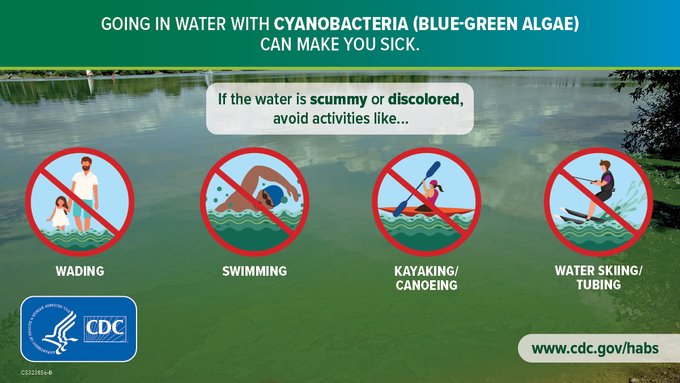Waterborne Disease (Surveillance)
Information about waterborne illness from swallowing impure recreational (lakes, rivers, etc.) or drinking water or food or beverages
Press Release: Legionnaire's Disease Associated with Meredith Woods and Clearwater Campground in Meredith, NH (March 21, 2023)
Waterborne illness is mainly caused by swallowing impure recreational (lakes, rivers, etc.) or drinking water. Many waterborne illnesses happen by eating/drinking impure food or beverages, from contact with animals or their environment, through person-to-person or breathing in impure water droplets. The United States has one of the safest drinking water supplies in the world. Yet, the water we use for drinking, swimming, and even cooling high-rise buildings can be safer. About 7.2 million Americans get sick every year from diseases spread through water.
Public Health Surveillance & Waterborne Diseases
Environmental data collection and review is not a new area of science, but rather includes the work that NH Department of Environmental Services (NHDES) does every day. For example, the Water Division performs data collection and observing as part of ambient groundwater sampling, as well as taking samples of rivers and lakes to observe and look for water quality trends over time. They make decisions based on this information with the main goal to protect human health and the environment.
Public health surveillance (data collection and review) may be used to track health-related issues showing up, early on and find active answers in a timely manner. Surveillance systems are most often asked to provide information about:
- When and where health problems happen and
- Who is affected.
Legionella
Legionnaires’ Disease Prevention Providing a Home for Guests, not Legionella
Your Hot Tub/Spa and Legionella
2018
The New Hampshire Department of Health and Human Services' Division of Public Health Services (DPHS) looked into an outbreak (upswing) of Legionnaire’s disease, a likely serious pneumonia, caused by a bacteria, in Hampton, New Hampshire in 2018. At least 34 individuals with signs like Legionnaires’ disease, who likely got their illness from the hot tub or the potable (drinkable) water system at The Sands Resort in Hampton, NH between May and August of 2018.
See the summary of this work effort at: Outbreak of Legionellosis Hampton, New Hampshire, 2018, Final Investigation Report
Harmful Algal Blooms
You can’t tell for sure if an algal or cyanobacterial bloom is harmful just by looking at it. Protect yourself and your pets by not swimming in bodies of water that smell bad or look discolored. When in doubt, stay out!
Algae and cyanobacteria are simple, plant-like organisms that live in water. Algae and cyanobacteria can quickly grow out of control, or “bloom.” Cyanobacteria blooms, also called blue green algae, are unpleasant in sight, odor and taste, as well as likely toxic to domestic animals, livestock, wildlife and humans.
Blooms of algae or cyanobacteria can harm people, animals, or the environment if the blooms
- Make toxins
- Become too dense
- Use up the oxygen in the water
- Release harmful gases
Cyanobacteria are a likely public health danger because they may produce toxins, overall referred to as “cyanotoxins,” that can be eaten by organisms in the food chain and released into the water when cells die. However, the amount and type of toxin produced varies over time and from lake to lake. A cyanobacterial bloom may produce very little to no toxin in one lake, and a later bloom in the same lake could produce a large toxin concentration.
Cyanotoxins can cause:
- Both acute (quick) and chronic (long term) illnesses,
- These toxins attack the:
- Liver
- Kidney
- Central nervous system
- And can bother the skin.
- Acute effects, such as skin and mucous membrane (nose, mouth, lungs) irritation, can happen after short-term exposure with water that has cyanotoxins.
- Chronic effects, such as liver, kidney and central nervous system damage, can happen over a long period of time from getting water containing toxins into the mouth, lungs or nose.
Avoid Harmful Algae and Cyanobacteria | Harmful Algal Blooms | CDC

Healthy and Safe Swimming Tips
Swimming and other water activities are excellent ways to get the physical activity and health benefits needed for a healthy life. Help prevent recreational water illnesses, which is illness caused by germs and chemicals found in the water we swim in.
- Keep the pee, poop, sweat, and dirt out of the water.
- Going for a swim with kids? Take a break every hour to use the bathroom or check diapers.
- Change diapers away from the water to keep germs from getting in the water.
- Did you know swallowing even a small amount of water contaminated with diarrhea germs can make you sick for up to 3 weeks? Don’t swallow the water you swim in!
More Healthy Swimming/Recreational Water | Healthy Swimming | Healthy Water | CDC
NH Department of Environmental Service's (DES) Resources
CDC Resources
- Harmful Algal Bloom (HAB)-Associated Illness
- Healthy Swimming
- Illness and Symptoms: Cyanobacteria in Fresh Water
- Legionella Overview
- Preventing Recreational Water Illnesses at Your Facility
- Recreational Water Illness
- Understanding Antibiotic Resistance in Water: A One Health Approach
- Waterborne Disease in the United States



